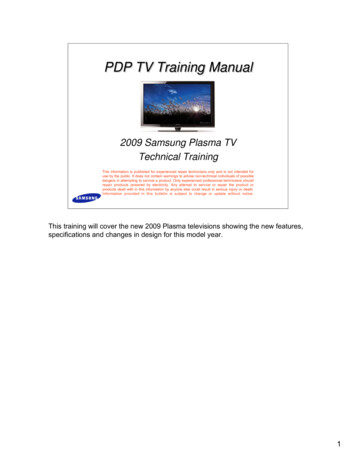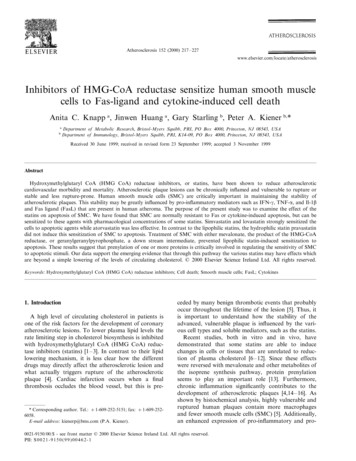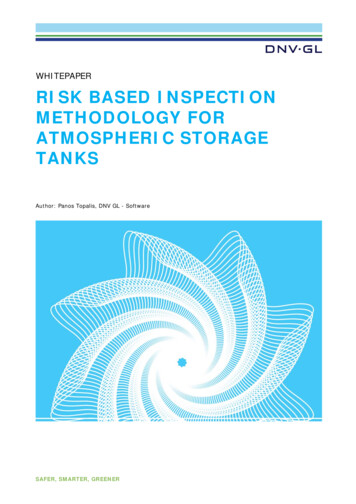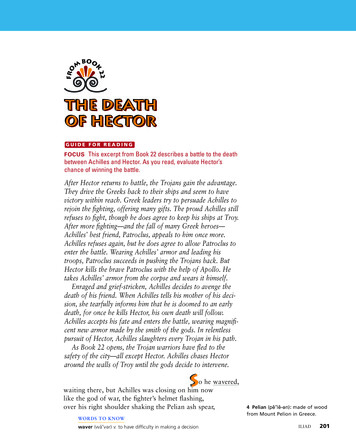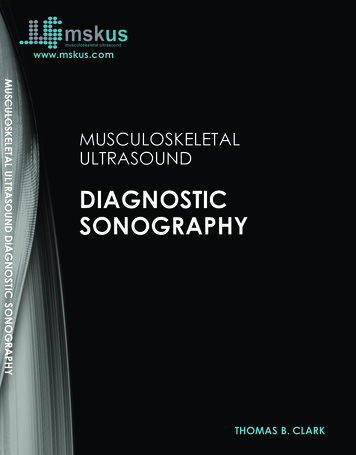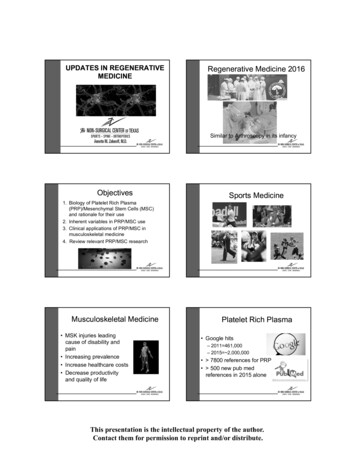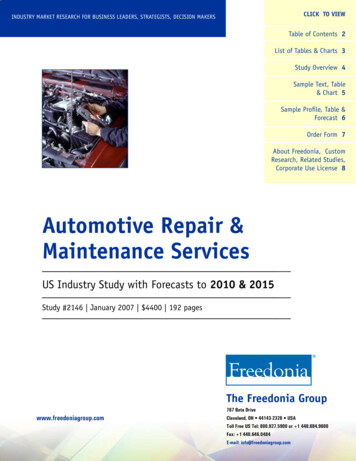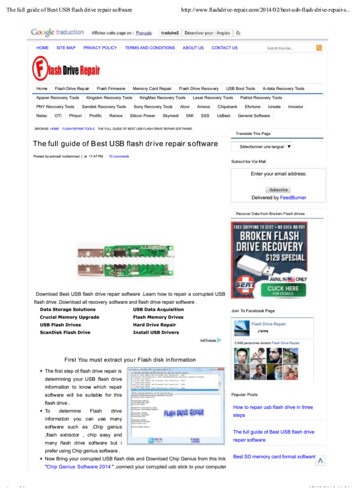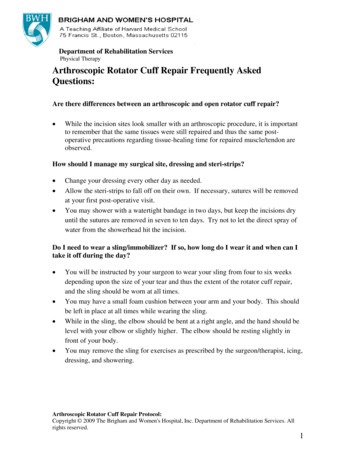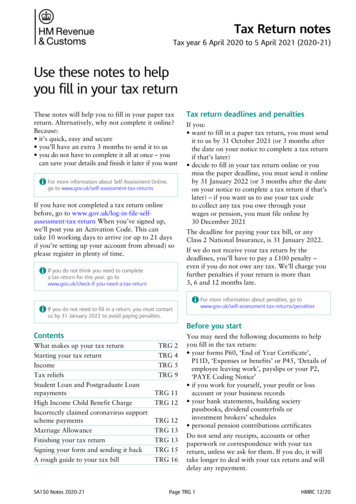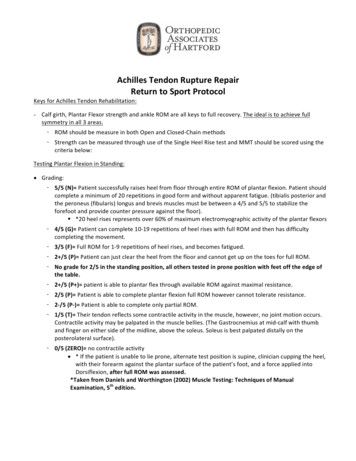
Transcription
Achilles Tendon Rupture RepairReturn to Sport ProtocolKeys for Achilles Tendon Rehabilitation:- Calf girth, Plantar Flexor strength and ankle ROM are all keys to full recovery. The ideal is to achieve fullsymmetry in all 3 areas.- ROM should be measure in both Open and Closed-Chain methods- Strength can be measured through use of the Single Heel Rise test and MMT should be scored using thecriteria below:Testing Plantar Flexion in Standing: Grading:- 5/5 (N) Patient successfully raises heel from floor through entire ROM of plantar flexion. Patient shouldcomplete a minimum of 20 repetitions in good form and without apparent fatigue. (tibialis posterior andthe peroneus (fibularis) longus and brevis muscles must be between a 4/5 and 5/5 to stabilize theforefoot and provide counter pressure against the floor).§ *20 heel rises represents over 60% of maximum electromyographic activity of the plantar flexors- 4/5 (G) Patient can complete 10-19 repetitions of heel rises with full ROM and then has difficultycompleting the movement.- 3/5 (F) Full ROM for 1-9 repetitions of heel rises, and becomes fatigued.- 2 /5 (P) Patient can just clear the heel from the floor and cannot get up on the toes for full ROM.- No grade for 2/5 in the standing position, all others tested in prone position with feet off the edge ofthe table.- 2 /5 (P ) patient is able to plantar flex through available ROM against maximal resistance.- 2/5 (P) Patient is able to complete plantar flexion full ROM however cannot tolerate resistance.- 2-/5 (P-) Patient is able to complete only partial ROM.- 1/5 (T) Their tendon reflects some contractile activity in the muscle, however, no joint motion occurs.Contractile activity may be palpated in the muscle bellies. (The Gastrocnemius at mid-calf with thumband finger on either side of the midline, above the soleus. Soleus is best palpated distally on theposterolateral surface).- 0/5 (ZERO) no contractile activity * If the patient is unable to lie prone, alternate test position is supine, clinician cupping the heel,with their forearm against the plantar surface of the patient’s foot, and a force applied intoDorsiflexion, after full ROM was assessed.*Taken from Daniels and Worthington (2002) Muscle Testing: Techniques of ManualExamination, 5th edition.
Postoperative Achilles Tendon Rupture Repair Return to Sport ProtocolImmediately Post-Op- Protection Phase (0-4 weeks Post-Op)Goals: Protect healing tissue Decrease/eliminate inflammation and edema, while controlling pain Prevent muscle atrophy and wound infection (to minimize scar formation)Patient Education: Posterior Splint or Boot must be worn day and night.Incision must be kept clean and dry.Non-Weight-Bearing for 3 weeks post-op, ambulation with bilateral crutchesCold Packs /Cryocuff should be used multiple times through the day with the leg elevated for first 1-2weeks, then PRNTreatments: Splint/Brace:- Posterior splint in 10 -20 plantar flexion 24 hours/day for first 3 weeks, Progressing to boot at week 3post-op (to be wore awake and while sleeping) with heel wedge to keep at 10 plantar flexion. Weight-Bearing:- Non-Weight-Bearing for first 3 weeks Post-op, then patient may begin partial Weight-Bearing withBilateral crutch in the boot with heel lift, (depending on MD Assessment). Modalities:- Cold Packs post treatment to control pain, swelling, and inflammation- Moist Hot Packs are not to be utilized until 2 weeks post-op Gait Training:- Gait and stair training with crutches, for proper technique Manual Therapies & ROM:- PROM: Clinician administered PROM is not to be performed for 8 Weeks post-op, Patient shouldperform Gravity-Assisted PROM into plantar flexion in a seated position (once incision is healed).- AROM: 3 weeks post-op patient may begin AROM exercises of the ankle, DF to neutral only withbent knee position, no active PF Proximal LE and Upper Body Kinetic Chain Strengthening Exercises:- No Ankle Strengthening for 1st 2 weeks, Sub-max. after 2 weeks no PF- 4-Way Hip SLR (Flex, Ext, Abd, Add), H/S curls- Foot Intrinsic Strengthening: Towel crutches, marbles, toe extension, etc.- Any UE and Core exercises in a LE non-weight-bearing position- Stationary Bicycle in the BootIntermediate Protection Phase: (4-8 Weeks)Goals: Continue to protect the healing Achilles repairContinue to decrease/eliminate pain and inflammationContinue to control/prevent muscular atrophyProgress to full weight-bearingRegain ankle range of motion (0 /neutral DF)(860) 549-8210 oahct.com
Patient Education: Educate patient on necessity to continue to wear the walking boot and adhere to restrictions to continueto protect the Achilles repair while early motion and weight-bearing is initiate/progressed. Brace must be worn whenever patient is in weight-bearing, it may be removed for shower/bath and toperform exercises.Treatments: Weight-Bearing:- Progress WBAT with Boot and 1-inch heel lift for 2 weeks, and then decrease to ½ inch heel lift, D/Ccrutches when full weight-bearing in boot is achieved. Modalities:- Continue all modalities PRN for pain, inflammation, and swelling Gait Training:- Gait Training progression from PWB/WBATèFWB as tolerated. Manual Therapies:- Gentle scar mobilization to Achilles- PROM may be initiated at 8 weeks post-op, gentle into DF initially Exercises:- Continue foot strengthening, SLR exercises, leg press (no PF movement)- Seated Baps Board, Ankle gentle AROM- (alphabets, rotations, pumping)- End-range Isometrics, supine/ seated calf raises (low/no resist)- Weight Shifting: Towel roll under heels @ 4 weeks (no boot)§ Bilateral stance with boot, progress to stagger stance –week 5- Continue Stationary Bicycle with boot- Continue Upper Body& Core exer. (seated/lying/CKC w/boot/LE on ball)Criteria for progression to Initial Strengthening phase: Full Weight-Bearing with Boot out of home, No Boot in home and clinicNo Increased symptoms with current AROM & PROM exercises0 -5 Dorsiflexion/ Neutral ankle ROM achieved- to be able to D/C bootSwelling/Edema controlledInitial Strengthening Phase ( 8-12 Weeks)Goals: Increase ROM to 10 Dorsiflexion, Achieve full ankle ROM INV, EV, PFContinue to progress weight bearing tolerance, D/C Walking Boot all surfaces ( 10 weeks)Normalized GaitRestore normal joint arthrokinematics of all foot and ankle jointsContinue to protect healing tissuesDecrease calf atrophyPatient Education: Education on progressing weight-bearing slowly, based on ROM and tolerance. Patient should continue to wear the boot, brace and/or heel lift until MD D/C’s(860) 549-8210 oahct.com
Treatments: Weight Bearing:- Continue to progress weight bearing to FWB’ing out of boot (with 1/4-1/2 inch heel lift inshoe/sneaker) 10 weeks post-op Gait Training: (MD may prescribe an ankle brace once boot is D/C’d).- 10 Weeks taper out of boot in the home and clinic, continue to wear out of the home. 12 weeks D/Cboot if appropriate (MD will D/C boot). Manual Therapies:- Manual Mobilization of foot & Midfoot, gentle Subtalar & Talo-Crural mobilization- to help restore footand ankle ROM- PROM all planes to improve foot and ankle mobility Exercises:- Light resistance band 4- way ankle exercise- gradually increase resistance- Seated (light resist), Standing (PWB) BAPS & decline boards- all planes- Forward, Retro and Lateral step up & downs- low step height- Progress DL heel raises supine, seated & add standing as tol. ( 12 weeks)- Continue LE, Foot intrinsic, Hip, Core, & UE exercises, & Leg Press- Continue LE bicycle, can begin Retro Treadmill walkingEnd of Phase Testing: Core Testing: (See attached sheets for description): 1-Segmental Multifidus Test, 2-Trunk Curl Up Test,3-Double-Leg Lowering Test, 4-Side Bridge Test, 5-Prone Bridge Test, 6-Supine Single-Leg Bridge Test, 7Extensor Endurance TestCriteria for progression to Advanced Strengthening phase: 10 Ankle Dorsiflexion, all other planes in normal ROMNo pain, inflammation or swellingNormal GaitNo increased symptoms with any of the current exercisesAdvanced Strengthening Phase ( 12-22 Weeks)Goals: Progress to full ankle ROM in all planesIncrease strength and balance to be able to begin advanced activity skillsNo calf/muscle atrophyD/C brace if still being used (by MD only)Get Achilles Tendon Total Rupture Score (ATRS)- Self -Reported Patient EvaluationGood proprioception/balance in single-leg stanceGradually introduce sub-maximal agility & reaction drills ( 18-20 weeks post-op), and sport-like activities(20-22 weeks post-op) Get baseline FMS Assessment Screen & Y-Balance Test ( 12-14 weeks) Initiate Walk-to Run ( 16-18 weeks post-op), LE Plyometric Protocols ( 18-20 weeks post-op)(860) 549-8210 oahct.com
Treatments: Continue to progress Dorsiflexion to normal ROM Continue to increase repetitions and resistance: As tolerated- 4-way ankle resistance band exercises- Standing DL calf raises, add eccentric lowering; SL toward end of phase§ Begin Heel Raise progression protocol (See Attached Sheet)- Anterior, Lateral, Retro step-ups & downs- increasing step height Continue to advance Core, Hip, and UE stabilization exercises Teach Injury Prevention/ Athletic Dynamics Stretching exercises- (See Sheets) Squats: DL (week 12), SL ( week 16)- 0-35 12 weeks post-op - 0-60 14 weeks post-opRetro treadmill walkingContinue leg press and add calf press raises- DL and SLAnterior posterior and lateral lungesBegin Walk-to Run Protocol ( 16-18 weeks post-op)- when SL Squat to 60 knee flexion with no kneevalgus or pain in LE, especially AchillesBegin LE Plyometric Protocol ( week18 post-op)Begin light sub-maximal Agility and Reaction drills, Sport-like activities ( 18-20 weeks post-op)- Straight line drills, ladder drills, step over cone drills, skipping, hoppingEnd of Phase Testing: FMS and Y-Balance Test LE score- FMS (goal of ³14/21 points with no 0/3, 1/3, or asymmetries) and Y-Balance score (GoalStatistically symmetrical to non-injured leg) Perform hop testing: See Attached Sheets- 2 practice trials, 2 timed/measured trials; average injured to non-injured- 1- Single-leg hop for distance- 2- Triple hop for distance- 3- Single-Leg Crossover triple hop- 4- 6-Metered timed hop- Hop-To-Stop Jump Tests: SL and SL with Opposite Landing- 3 trials of each bilateral- Tuck Jump- 2 trials for 10 seconds each (See Scoring Criteria)- DL Jump Test- Modified with hands behind back- (See Scoring Criteria) SL Squat Test: (0 -60 ):- No knee valgus or ankle instability noted Dorsiflexion Lunge Test (bilateral) Core Testing: Re-Test (Goal- No major dysfunction/ strength deficits noted)- Segmental Multifidus Test- Trunk Curl Up Test- Double-Leg Lowering Test- Side Bridge Test- Prone Bridge Test(860) 549-8210 oahct.com
- Supine Single-Leg Bridge Test- Extensor Endurance TestCriteria to progress to Return to Activity Phase1- Full ROM2- No pain or inflammation3- A score of ³14/21 on the FMS Assessment Screen, with No 0/3 pain on any of the 7 fundamentalmovement patterns4- No statistical asymmetries and on the Y-Balance Test 5- Hop Tests (90% or higher compared to non-injured leg)6- Limb Symmetry Index (LSI) of 90% or greater on hop tests7- No major deficits noted with Core and SL Squat testing8- 25 Dorsiflexion Lunge TestReturn to Activity Phase ( 22-32 weeks)* Patient may not still be in Rehab at this point on a regular basis, so home exercises program needs to bedemonstrated, and explained in detailed (pictures and written).- If Patient is continuing PT at home, it is expected that they are to be re-evaluated every 4-6 weeks foradvancement of exercises as well as determining progression.Goals: Continue to increase to full LE strengthContinue to increase power, endurance, agility, coordination, and balanceGradual return to sport activitiesGet Achilles Tendon Total Rupture Score (ATRS)- Self -Reported Patient EvaluationTreatment: Continue advanced strengthening, core, proprioceptive, and mobility exercisesContinue/Finish Heel Raise Progression Protocol (See Attached Sheet)Continue Walk-to-Run Protocol- if not completed to running 2 milesTeach Sport Specific Dynamic Stretching routine/Warm-up (See Sheets)Complete LE Plyometric Protocol- Progress to Box Jumps Progress agility and reaction exercises- increase speed, distance, and perturbations Begin Interval Running Protocol- when cleared by MD to perform cutting and sprinting activities Begin Interval Sport Protocol (ex. Kicking, Throwing, etc.) based on the sport patient will be returning(See Sheets)Functional Testing: for progression to sport-specific training/Return to Sport-*Can be perform over multipledays- See Attached Sheets for descriptions of tests and norms for dataStrength and Power Testing:-Sargent Vertical Jump TestFigure-8 Hop TestUp-Down TestHexagon Test (DL), Modified Hexagon Hop Test (SL)(860) 549-8210 oahct.com
Speed, Agility, and Quickness Testing:Agility T-Test, or Modified Agility T-Test (MAT)Three-Cone Drill TestSlalom TestBackward Movement Agility TestZigzag Run TestLower Extremity Functional Test (LEFT)-Core Testing:Segmental Multifidus TestTrunk Curl Up TestDouble-Leg Lowering TestSide Bridge TestProne Bridge TestSupine Single-Leg Bridge TestExtensor Endurance Test-Hop/Jump Testing:- 2 practice trials, 2 timed/measured trials; average injured to non-injured- 1- Single-leg hop for distance- 2- Triple hop for distance- 3- Single-Leg Crossover triple hop- 4- 6-Metered timed hop- Hop-To-Stop Jump Tests: SL and SL with Opposite Landing- 3 trials of each bilateral- Tuck Jump- 2 trials for 10 seconds each (See Scoring Criteria Sheets)- DL Jump Test- Modified with hands behind back- 2 trials (See Scoring Criteria Sheets)Function, Balance, and Endurance Testing:- FMS Assessment Screen- Y-Balance Test - Vail Sport Test*Return-to-Sport ActivitiesCriteria for Return-to-Specific Sport Activities: *Ultimate decision is made by MD Achilles Tendon Total Rupture Score (ATRS): 95/100 A score of ³16/21 on the FMS Assessment Screen, with no pain or asymmetries, especially withInline-lunge, and 2 or greater on all 7 fundamental movement patterns Y-Balance Test - No asymmetries and a composite score as close to 100 as possible Limb Symmetry Index (LSI) of ³95% on SL hop tests compared to Uninjured Leg LEFT Score: 117 seconds (females), 105 seconds (males) Vail Sport Test : 46/54 points Isokinetic testing: (if available) Quadriceps (90% or greater) compared to non-injured legHamstring (100%-110%) compared to non-injured leg- Hamstring-Quadriceps Ratio (80% or greater)DL Jump and Tuck Jump: meets scoring criteria(860) 549-8210 oahct.com
Sargent Vertical Jump: See chart for norms based on age of athleteAgility T-Test: Adults: 8.9-13.5 seconds, Adolescents: Dorsiflexion Lunge Test: distance of foot to wall 9 cm, & tibial shaft angle 35 No discomfort or swelling, and passing/statistically equal to normative values (if available) with aboveFunctional TestsHeel Raise Progression Protocol- Phase 1: Performed by patient Daily- 3X/ Day 20 Repetitions per session Technique: Double-Leg Heel Raises- Both heel Up and Down simultaneously Duration 2-4 weeks- Phase 2: Performed 5 days/ Week (2 days on, 1 Day off)- 1-2X/ Day Technique:§ DL Heel Raise Up and Down together X 10 Repetitions§ DL Heel Raise Up together, Raise Unaffected Leg and Down/Lower Affected Leg Only X 10Repetitions§ DL Heel Raise Up and Down Together X 10 Repetitions Duration 2 weeks- Phase 3: Performed 5 days/ Week (2 days on, 1 Day off)- 1-2X/ Day Technique:§ DL Heel Raise Up and Down together X 10 Repetitions§ DL Heel Raise Up together, Raise Unaffected Leg and Down/Lower Affected Leg Only X 10Repetitions§ DL Heel Raise Up and Down Together X 10 Repetitions Duration 2 weeks- Phase 4: Performed 5 days/ Week (2 days on, 1 Day off)- 1X/ Day Technique:§ DL Heel Raise Up and Down together X 10 Repetitions§ DL Heel Raise Up together, Raise Unaffected Leg and Down/Lower Affected Leg Only X 10Repetitions§ SL Heel Raise Affected Leg Only Up and Down X 10 Repetitions§ DL Heel Raise Up and Down Together X 10 Repetitions Duration 2 weeks- Phase 5: Performed 4 days/ Week (2 days on, 2 Day off)- 1X/ Day Technique:§ DL Heel Raise Up and Down together X 10 Repetitions§ DL Heel Raise Up together, Raise Unaffected Leg and Down/Lower Affected Leg Only X 10Repetitions§ SL Heel Raise Affected Leg Only Up and Down X 10 Repetitions, 2 sets per session§ DL Heel Raise Up and Down Together X 10 Repetitions Duration 2 weeks- Phase 6: Performed 3-4 days/ Week (1 days on, 1 Day off)- 1X/ Day Technique:§ DL Heel Raise Up and Down together X 10 Repetitions§ DL Heel Raise Up together, Raise Unaffected Leg and Down/Lower Affected Leg Only X 10Repetitions§ SL- Affected Leg Only Up and Down X 10 Repetitions, 3 sets§ DL Heel Raise Up and Down Together X 10 Repetitions Duration 1 month(860) 549-8210 oahct.com
References- Akizuki et al. The relative Stress on the Achilles Tendon During Ambulation in an Ankle Immobiliser:Implications for Rehabilitation After Achilles Tendon Repair. Br J Sports Med. 2001; 35: 329-334.- Amin et al. Performance Outcomes After Repair of Complete Achilles Tendon Ruptures in National BasketballAssociation Players. Am J Sports Med. 2013; 41(8): 1864-1868.- Clanton et al. Return to Play in Athletes Following Ankle Injuries. Sports Health. 2012; 4(6): 471-474.- Cook, Gray. Movement: Functional Movement Systems (book). 2010; ON Target Publications.- Garrison et al. The Reliability of the Vail Sport Test as a Measure of Physical Performance Following AnteriorCruciate Ligament Reconstruction. Inter J Sports Phys Ther. 2012; 7(1):20-30.- Goulbourne, Shaun. Sports-Related Injuries in the Young Athlete (book from training course). 2011; CrossCountry Education, LLC.- Hamilton et al. Triple Hop Distance as a Valid Predictor of Lower Limb Strength and Power. J Athletic Training.2008; 43(2): 144-151.- Hewett et al. Understanding and Preventing ACL Injuries: Current Biomechanical and EpidemiologicConsiderations- Update 2010. N Am J Sports Phys Ther. 2010; 5(4): 234-251.- Huang et al. Rehabilitation Regimen After Surgical Treatment of Acute Achilles Tendon Ruptures: A SystematicReview with meta-analysis. Am J Sports Med. 2014; 43(4): 1008-1016.- Kangas et al. Achilles Tendon Elongation After Rupture Repair. Am J Sports Med. 2007; 35(1): 59-64.- Kangas et al. Early Functional Treatment Versus Early Immobilization in Tension of the Musculotendinous UnitAfter Achilles Rupture Repair: A Prospective, Randomized, Clinical Study. J Trauma Acute Care Surg. 2003; 6:1171-1180.- Maffulli et al. Early Weight-Bearing and Ankle Mobilization After Open Repair of Acute Mid-Substance Tearsof the Achilles Tendon. Am J Sports Med. 2003. 31(5): 692-700.- Kearney et al. The Achilles Tendon Total Rupture Score: a Study of Responsiveness, Internal Consistency andConvergent Validity on Patients with Acute Achilles Tendon Ruptures. Health and Quality of Life Outcomes.2012; 10:24 1-7.- Maffulli, N. Current Concepts Review- Rupture of the Achilles Tendon. J Bone Joint Surg Am. 1999; 81: 10191036.- Maquirriain, J. Achilles Tendon Rupture: Avoiding Tendon Lengthening During Surgical Repair andRehabilitation. Yale J Bio Med. 2011; 84: 289-300.- McNair et al. Biomechanical Properties of the Plantar Flexor Muscle-Tendon Complex 6 Months Post-Ruptureof the Achilles Tendon. J Ortho Res. 2013; 9999: 1-7.- Nilsson-Helander et al. The Achilles Tendon Total Rupture Score (ATRS) Development and Validation. Am JSports Med. 2007; 35(3): 421-425.(860) 549-8210 oahct.com
- Padua et al. The Landing Error Scoring System (LESS) is a Valid and Reliable Clinical Assessment Tool of JumpLanding Biomechanics: The Jump-ACL Study, Am J Sports Med. 2009; 10:1996-1002.- Power et al. Delayed Recovery of Velocity-Dependent Power Loss Following Eccentric Actions of the AnkleDorsiflexors. J Appl Physiol. 2010; 109: 669-676.- Reiman, Michael P., Manske, Robert C. Functional Testing in Human Performance: 139 tests for sport, fitness,and Occupational Settings (book). 2009. Human Kinetics.- Rettig et al. Potential Risk of Rerupture in primary Achilles Tendon Repair in Athletes Younger Than 30 Yearsof Age. Am J Sports Med. 2005; 33(1): 119-123.- Ross MD, Langford B, Whelan PJ. Test-retest Reliability of 4 Single-Leg Horizontal Hop Tests. J Stength CondRes. 2002; 4:617-622.- Saxena, A, Ewen, B, Maffulli, N. Rehabilitation of the Operated Achilles Tendon: Parameters for PredictingReturn to Activity. J Foot Ankle Surg. 2011; 50: 37-40.- Strom, AC, Casillas, MM. Achilles Tendon Rehabilitation. Foot Ankle Clin N Am. 2009; 14: 773-782.- Suchak et al. Postoperative Rehabilitation Protocols for Achilles Tendon Ruptures: A Meta-analysis. Clin OrthoRel Res. 2006; 445: 216-221.(860) 549-8210 oahct.com
- Calf girth, Plantar Flexor strength and ankle ROM are all keys to full recovery. The ideal is to achieve full symmetry in all 3 areas. - ROM should be measure in both Open and Closed-Chain methods - Strength can be measured through use of the Single Heel Rise test and MMT should be scored using the criteria below:
